MySQL
> Alexis
> Computing
> Database
A Quick Guide to Using the MySQL APT Repository. Steps for a Fresh Installation of MySQL Adding the MySQL APT Repository First, add the MySQL APT repository to your system's software repository list.
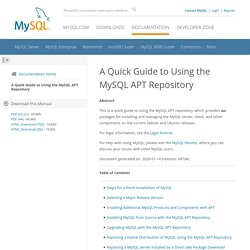
Follow these steps: Go to the download page for the MySQL APT repository at Select and download the release package for your Linux distribution. Install the downloaded release package with the following command, replacing version-specific-package-name with the name of the downloaded package (preceded by its path, if you are not running the command inside the folder where the package is): shell> sudo dpkg -i /PATH/version-specific-package-name.deb For example, for version w.x.y-z of the package, the command is: shell> sudo dpkg -i mysql-apt-config_w.x.y-z_all.deb Note that the same package works on all supported Debian and Ubuntu platforms.
New in 5.6-8.0
Q&A: Common (but Deadly) MySQL Development Mistakes. This article was originally written by Bill Karwin Recently I gave a presentation on “How to Avoid Common (but Deadly) MySQL Development Mistakes” for Percona MySQL Webinars.
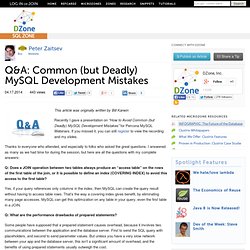
If you missed it, you can still register to view the recording and my slides. Thanks to everyone who attended, and especially to folks who asked the great questions. I answered as many as we had time for during the session, but here are all the questions with my complete answers:
Infographic: MySQL Disasters in the Cloud. 10inShare We Recommend These Resources Curator's Note: The content of this article was originally written by Avigail Ofer on the Xeround blog.
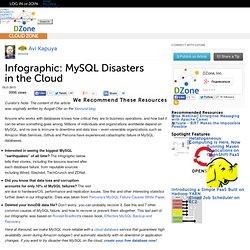
Anyone who works with databases knows how critical they are to business operations, and how bad it can be when something goes wrong. Millions of individuals and organizations worldwide depend on MySQL, and no one is immune to downtime and data loss – even venerable organizations such as Amazon Web Services, Github and Percona have experienced catastrophic failure of MySQL databases. Interested in seeing the biggest MySQL “earthquakes” of all time? Here at Xeround, we make MySQL more reliable with a cloud database service that guarantees high availability (even during Amazon outages!) (Click to enlarge infographic)
Vitess - Scaling MySQL databases for the web. The project is now hosted on Please use the new location to watch our progress.
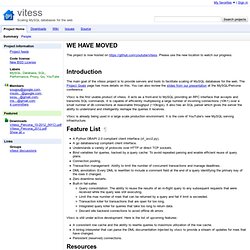
The main goal of the vitess project is to provide servers and tools to facilitate scaling of MySQL databases for the web. The Project Goals page has more details on this. You can also review the slides from our presentation at the MySQL/Percona conference. Vtocc is the first usable product of vitess.
3 Biggest MySQL Migration Surprises. Once a development or operations team gets over the hurdle of open-source, and start to feel comfortable with the way software works outside of the enterprise world, they will likely start to settle in and feel comfortable.
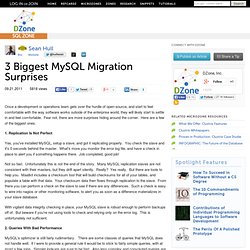
Fear not, there are more surprises hiding around the corner. Here are a few of the biggest ones. 1. Replication Is Not Perfect Yes, you've installed MySQL, setup a slave, and got it replicating properly.
Incorrect string value
MySQL Limitations Part 1: Single-Threaded Replication. I recently mentioned a few of the big “non-starter” limitations Postgres has overcome for specific use cases.

I decided to write a series of blog posts on MySQL’s unsolved severe limitations. I mean limitations that really hobble it for major, important needs — not in areas where it isn’t used, but in areas where it is used and thus is used very wastefully compared to its potential. The first glaring problem is single-threaded replication. It is severe and getting much worse as servers get more and more CPUs and CPU cores. The replication replay process executes in a single thread on the replicas, and thus has no hope of keeping up with even a moderately busy write load on the primary, where many updates are occurring concurrently.
In a lot of Web applications, this isn’t really seen as a huge limitation.
MySQL Fork "Drizzle" Shows Signs of Life. While other Sun projects such as OpenSolaris and OpenOffice.org were driven to make forks (Illumos and LibreOffice respectively) under Oracle's new leadership style, MySQL forks are not in the same position.

Oracle seems to be relatively committed to the MySQL community, but this hasn't stopped older forks from moving forward. One fork of MySQL that was started over three years ago is just now reaching beta quality according to the developers. This is the Drizzle project, which just released build 1802 - now referred to as Drizzle 7. The new version of Drizzle includes a much better 'drizzledump' tool, which now has the ability to migrate databases from MySQL to Drizzle without any intermediate files.
MongoDB is Web Scale « myNoSQL. MySQL is Not ACID Compliant « myNoSQL. Error code [1366]; Incorrect string value: '\xF4\x80\x80\xB9Bu...'
I have very strange exceptions, using JDBC-client, UTF-8 for both parties, and LONGTEXT field: 2007-05-22 21:53:16,849 [eshop.macsales.com ] ERROR org.tokenizer.fetcher.FetcherThread - org.springframework.jdbc.UncategorizedSQLException: PreparedStatementCallback; uncategorized SQLException for SQL [update web_resource set url_actual=?
![error code [1366]; Incorrect string value: '\xF4\x80\x80\xB9Bu...'](http://cdn.pearltrees.com/s/pic/th/mysql-error-incorrect-string-5443030)
, last_success_time=?
, fail_num=?
, status_code=?
, status_text=?
Profiling
MySql deadlocks. MySql tmp tables. Replication. Converting MySQL database to Postgresql. Filed under: Programming · Date: Mon Sep 6 21:10:49 2004 The majority of Open Source applications utilizing a database backend are programmed only for the most common and easy to use RDBMS -- MySQL.
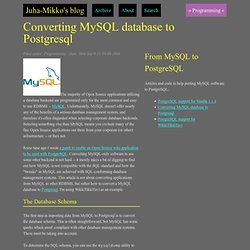
Unfortunately, MySQL doesn't offer nearly any of the benefits of a serious database management system, and therefore it's often disgarded when selecting corporate database backends. Selecting something else than MySQL means you exclude many of the fine Open Source applications out there from your corporate (or other) infrastructure -- or then not. Some time ago I wrote a patch to enable an Open Source wiki application to be used with PostgreSQL.
The Doom of Multiple Storage Engines. We Recommend These Resources One of the big “Selling Points” of MySQL is support for Multiple Storage engines, and from the glance view it is indeed great to provide users with same top level SQL interface allowing them to store their data many different way.
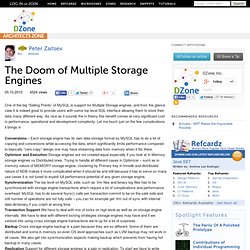
As nice as it sounds the in theory this benefit comes at very significant cost in performance, operational and development complexity. Let me touch just on the few complications it brings in Conversions – Each storage engine has its own data storage format so MySQL has to do a lot of copying and conversions while accessing the data, which significantly limits performance compared to basically “zero copy” design one may have streaming data from memory when it fits there. Optimizer and Execution Storage engines are not created equal especially if you look at In Memory storage engines vs Distributed ones.








![error code [1366]; Incorrect string value: '\xF4\x80\x80\xB9Bu...'](http://cdn.pearltrees.com/s/pic/th/mysql-error-incorrect-string-5443030)

